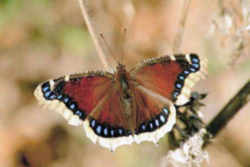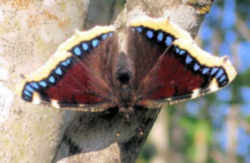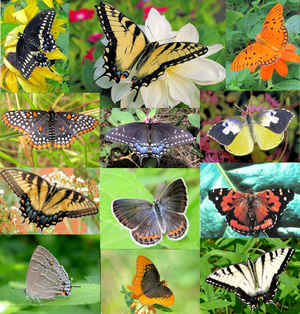
Montana Symbols
Montana State Butterfly
Mourning Cloak Butterfly

(Nymphalis antiopa)
Adopted on March 28, 2001.
The Mourning Cloak, (Nymphalis antiopa,) was named the state butterfly for Montana in 2001. Often the first butterflies to emerge in the spring (frequently before the winter snow has melted), mourning cloaks rest on tree trunks and turn their dark wings toward the sun to absorb heat for flight.
Thanks to House Bill no. 365, sponsored primarily by James Whitaker.
Montana State Butterfly: Mourning Cloak Butterfly

The North American common
name for this species, mourning cloak, refers to its resemblance to a traditional dark colored cloak worn when one was "in mourning."
The mourning cloak's dark brown wings are characterized by bright blue shimmering spots along the inner edge of a yellow or beige border. If viewed
closely, you may see that their wings reflect purple highlights. The underside of the wings are dark brown with lighter brown edges.
Characteristics of the Mourning Cloak Butterfly
Nymphalis antiopa, known as the Mourning Cloak in North America and the Camberwell Beauty in Britain, is a large butterfly native to Eurasia and North America.
The immature form of this species is sometimes known as the spiny elm caterpillar. Other older names for this species include Grand Surprise and White Petticoat. A powerful flier, this species is sometimes found in areas far from its usual range during migration.
These butterflies have a life-span of 11 to 12 months, one of the most extensive life-spans for any butterfly.
Mourning Cloak (Nymphalis antiopa [Linnaeus])
Wing span: 2 1/4 - 4 inches (5.7 - 10.1 cm).
Identification: Short projections on both wings, borders irregular. Upperside is purple-black with a wide, bright yellow border on outer margins, and a row of iridescent blue spots at the inner edge of the border.
Life history: Overwintered adults mate in the spring, the males perching in sunny openings during the afternoon to wait for receptive females. Eggs are laid in groups circling twigs of the host plant. Caterpillars live in a communal web and feed together on young leaves, then pupate and emerge as adults in June or July. After feeding briefly, the adults estivate until fall, when they re-emerge to feed and store energy for hibernation. Some adults migrate south in the fall.
Flight: Usually one flight from June-July.
Caterpillar hosts: Willows including black willow (Salix nigra), weeping willow (S. babylonica), and silky willow (S. sericea); also American elm (Ulmus americana), cottonwood (Populus deltoides), aspen (P. tremuloides), paper birch (Betula papyrifera), and hackberry (Celtis occidentalis). Older caterpillars wander about and may be found on plants that they do not eat.
Adult food: Mourning Cloaks prefer tree sap, especially that of oaks. They walk down the trunk to the sap and feed head downward. They will also feed on rotting fruit, and only occasionally on flower nectar.
Habitat: Because Mourning Cloaks roam and migrate, they are found almost anywhere that host plants occur including woods, openings, parks, and suburbs; and especially in riparian areas.
Range: All of North America south of the tundra to central Mexico; rarely in the Gulf States and peninsular Florida. Also native to temperate Eurasia.
Montana Law
The law designating the mourning cloak as the official Montana state butterfly is found in the Montana Revised Statutes, Title 1, Chapter 1.
TITLE 1. GENERAL LAWS AND DEFINITIONS
CHAPTER 1. GENERAL PROVISIONS
Part 5. State Symbols - Official Designations
1-1-514. State butterfly. The mourning cloak, Nymphalis antiopa, is the official Montana state butterfly.
History: En. Sec. 1, Ch. 155, L. 2001.
Taxonomic Hierarchy: Mourning Cloak Butterfly
Kingdom: Animalia (Animals)
Phylum: Arthropoda (Arthropods)
Subphylum: Hexapoda (Hexapods)
Class; Insecta (Insects)
Order: Lepidoptera (Butterflies and Moths)
Superfamily; Papilionoidea (Butterflies and Skippers)
Family: Nymphalidae (Brush-footed Butterflies)
Subfamily: Nymphalinae (Crescents, Checkerspots, Anglewings, etc.)
Tribe: Nymphalini
Genus: Nymphalis (Tortoiseshells)
Species: antiopa (Mourning Cloak - Hodges#4432)
Butterflies, and Bugs







